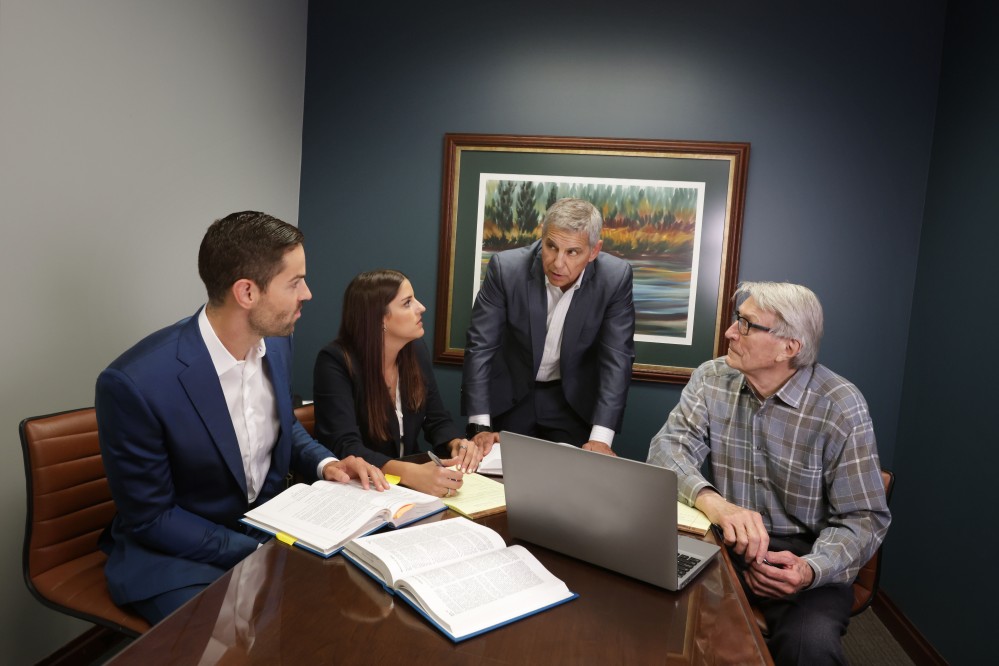4 Indiana Ave Valparaiso, IN 46383
in**@*******aw.com

Pedestrian accidents often happen without warning, leaving victims with life-changing injuries, emotional distress, and overwhelming financial challenges. If you or a loved one has been hurt—or tragically killed—in a pedestrian accident in Indiana, you have the right to pursue justice and full compensation.
When you choose Langer & Langer, you’re not just hiring a lawyer—you’re gaining the support of an entire legal team that truly understands what you and your family are facing. Our Indiana pedestrian accident attorneys bring over 100 years of combined experience representing injured victims statewide. We handle cases involving crosswalk collisions, hit-and-run accidents, drunk or distracted driving, intersection crashes, and more.
Our team is dedicated to holding negligent drivers accountable and securing compensation for medical expenses, lost wages, pain and suffering, and other damages. We handle the legal burden so you can focus on healing.
Don’t risk your recovery. Contact Langer & Langer online or call 219-533-2744 today for a free consultation with an experienced pedestrian accident lawyer in Indiana.
Pedestrian accidents are an undeniable problem for the people of Indiana and throughout the nation. According to the National Highway Traffic Safety Administration (NHTSA), 6,205 pedestrians were killed in the United States in 2019, the most recent year for which data was available. That is equal to one pedestrian fatality every 85 minutes. In Indiana, there were 1,573 pedestrian collisions that same year. Approximately 11% of people killed in fatality traffic accidents in the state were pedestrians. Victims who survived often suffered catastrophic injuries that left them unable to work, paralyzed, or dependent on life-sustaining medical equipment to survive.
Drivers and vehicle operators in Indiana owe a duty of care to pedestrians. Failure to exercise reasonable care constitutes negligence, and the at-fault party can be held legally liable for injuries or deaths. Many of the same negligent behaviors that cause pedestrian accidents also contribute to car crashes, truck collisions, bicycle accidents, and motorcycle accidents in Indiana. Common factors for pedestrian accidents include:
Distracted Driving: Texting, eating, or other distractions can cause collisions with pedestrians and also put bicyclists, motorcyclists, and other drivers at risk.
Driving While Impaired by Alcohol or Drugs: Impairment is a leading cause of pedestrian injuries, as well as Indiana car accident injury claims, truck wrecks, and motorcycle crashes.
Drowsy Driving: Fatigue can lead to accidents involving pedestrians.
Failing to Obey Traffic Signs and Signals: Ignoring stop signs or traffic lights endangers pedestrians first and foremost, as well as other road users.
Failing to Use Caution in School Zones or Crosswalks: Children walking or biking are particularly vulnerable to negligent drivers of trucks, cars, or motorcycles.
Failing to Use Turn Signals: Sudden or unexpected turns can cause collisions with pedestrians.
Failing to Yield the Right-of-Way: Drivers must watch carefully for pedestrians, who are the most vulnerable, while also avoiding collisions with cyclists and motorcyclists.
Not Checking Rear View Mirrors or Back-Up Cameras: Unsafe backing up can cause serious injuries to pedestrians, particularly children.
Speeding or Driving Too Fast for Conditions: Excessive speed increases the severity of accidents involving pedestrians.
Indiana law allows pedestrians who are hit by motor vehicles to file personal injury claims or lawsuits against the negligent party to receive compensation. Compensatory damages are designed to compensate the victim for out-of-pocket expenses and other losses caused by the collision. These are often referred to as economic and non-economic damages. If the at-fault driver has little or no insurance, an uninsured/underinsured motorists law firm can help maximize your claim.
If you were hit by a motor vehicle and the driver was negligent, our Indiana pedestrian accident lawyers may be able to help you receive payment for:
You may be entitled to compensation to pay for the care you received from paramedics at the scene, the ambulance, emergency room treatment, surgeries, extended hospital stays, x-rays and other imaging, laboratory tests, prescription medications, medical devices and equipment, in-home nursing care, and medically necessary modifications to your home or vehicle.
Unlike compensatory damages, which are designed to make the victim whole, punitive damages are intended to punish the wrongdoer and prevent similar actions in the future. These damages are sometimes awarded in cases involving malicious acts and those that are extremely reckless. In pedestrian cases that involve Uber or Lyft drivers, a rideshare accident attorney in Indiana can help ensure the responsible parties are held accountable.
Pedestrian accident victims in Indiana generally have two years from the date of the injury to file a lawsuit in civil court. Exceptions exist, however. A pedestrian accident attorney can evaluate your case to determine whether special circumstances exist.
Yes. Indiana law permits parents to sue negligent drivers on behalf of injured children who are minors. You may be able to recover for your child’s economic and non-economic losses.
If the driver who hit you was uninsured or underinsured, you can often recover compensation by filing a claim under your own uninsured or underinsured motorist insurance, which may cover medical bills, lost wages, and other damages.
If you’re injured as a pedestrian, seek medical attention and document the accident with photos, witnesses, and police reports. An experienced Indiana pedestrian accident lawyer can help prove another party’s negligence, gather evidence, and file a claim to recover compensation for medical bills, lost wages, and pain and suffering.
Yes. In Indiana, drivers must yield to pedestrians in marked or unmarked crosswalks, and pedestrians generally have the right of way. However, pedestrians must exercise reasonable care, use designated crosswalks, and obey traffic signals to avoid jaywalking. Understanding your rights is important if you are injured, and an Indiana pedestrian accident lawyer can help protect them.
Yes, hitting a pedestrian is considered a traffic accident or pedestrian crash. While drivers often have a duty of care, both parties can be partially responsible depending on factors like jaywalking or ignoring traffic signals. These collisions can lead to serious injuries and may involve civil or criminal liability. Legal guidance from an Indiana pedestrian accident lawyer is recommended to determine fault and pursue compensation.
Pedestrians are highly vulnerable in collisions, commonly suffering broken bones, head or brain injuries, spinal injuries, soft tissue damage, and internal injuries. Prompt medical care and an Indiana pedestrian accident lawyer can help protect your recovery and secure compensation.



© 2025 Langer & Langer • All Rights Reserved
Disclaimer | Site Map | Privacy Policy | Payment | Business Development Solutions by Blue Summit SEO.
Copyright © 2025 All Rights Reserved.
Past results do not guarantee any future outcome, and every case is different.
We improve our products and advertising by using Microsoft Clarity to see how you use our website. By using our site, you agree that we and Microsoft can collect and use this data.
Have legal questions or need expert advice? Our experienced team is here to help.
Langer & Langer
We firmly believe that the internet should be available and accessible to anyone, and are committed to providing a website that is accessible to the widest possible audience, regardless of circumstance and ability.
To fulfill this, we aim to adhere as strictly as possible to the World Wide Web Consortium’s (W3C) Web Content Accessibility Guidelines 2.1 (WCAG 2.1) at the AA level. These guidelines explain how to make web content accessible to people with a wide array of disabilities. Complying with those guidelines helps us ensure that the website is accessible to all people: blind people, people with motor impairments, visual impairment, cognitive disabilities, and more.
This website utilizes various technologies that are meant to make it as accessible as possible at all times. We utilize an accessibility interface that allows persons with specific disabilities to adjust the website’s UI (user interface) and design it to their personal needs.
Additionally, the website utilizes an AI-based application that runs in the background and optimizes its accessibility level constantly. This application remediates the website’s HTML, adapts Its functionality and behavior for screen-readers used by the blind users, and for keyboard functions used by individuals with motor impairments.
If you’ve found a malfunction or have ideas for improvement, we’ll be happy to hear from you. You can reach out to the website’s operators by using the following email
Our website implements the ARIA attributes (Accessible Rich Internet Applications) technique, alongside various different behavioral changes, to ensure blind users visiting with screen-readers are able to read, comprehend, and enjoy the website’s functions. As soon as a user with a screen-reader enters your site, they immediately receive a prompt to enter the Screen-Reader Profile so they can browse and operate your site effectively. Here’s how our website covers some of the most important screen-reader requirements, alongside console screenshots of code examples:
Screen-reader optimization: we run a background process that learns the website’s components from top to bottom, to ensure ongoing compliance even when updating the website. In this process, we provide screen-readers with meaningful data using the ARIA set of attributes. For example, we provide accurate form labels; descriptions for actionable icons (social media icons, search icons, cart icons, etc.); validation guidance for form inputs; element roles such as buttons, menus, modal dialogues (popups), and others. Additionally, the background process scans all the website’s images and provides an accurate and meaningful image-object-recognition-based description as an ALT (alternate text) tag for images that are not described. It will also extract texts that are embedded within the image, using an OCR (optical character recognition) technology. To turn on screen-reader adjustments at any time, users need only to press the Alt+1 keyboard combination. Screen-reader users also get automatic announcements to turn the Screen-reader mode on as soon as they enter the website.
These adjustments are compatible with all popular screen readers, including JAWS and NVDA.
Keyboard navigation optimization: The background process also adjusts the website’s HTML, and adds various behaviors using JavaScript code to make the website operable by the keyboard. This includes the ability to navigate the website using the Tab and Shift+Tab keys, operate dropdowns with the arrow keys, close them with Esc, trigger buttons and links using the Enter key, navigate between radio and checkbox elements using the arrow keys, and fill them in with the Spacebar or Enter key.Additionally, keyboard users will find quick-navigation and content-skip menus, available at any time by clicking Alt+1, or as the first elements of the site while navigating with the keyboard. The background process also handles triggered popups by moving the keyboard focus towards them as soon as they appear, and not allow the focus drift outside it.
Users can also use shortcuts such as “M” (menus), “H” (headings), “F” (forms), “B” (buttons), and “G” (graphics) to jump to specific elements.
We aim to support the widest array of browsers and assistive technologies as possible, so our users can choose the best fitting tools for them, with as few limitations as possible. Therefore, we have worked very hard to be able to support all major systems that comprise over 95% of the user market share including Google Chrome, Mozilla Firefox, Apple Safari, Opera and Microsoft Edge, JAWS and NVDA (screen readers).
Despite our very best efforts to allow anybody to adjust the website to their needs. There may still be pages or sections that are not fully accessible, are in the process of becoming accessible, or are lacking an adequate technological solution to make them accessible. Still, we are continually improving our accessibility, adding, updating and improving its options and features, and developing and adopting new technologies. All this is meant to reach the optimal level of accessibility, following technological advancements. For any assistance, please reach out to